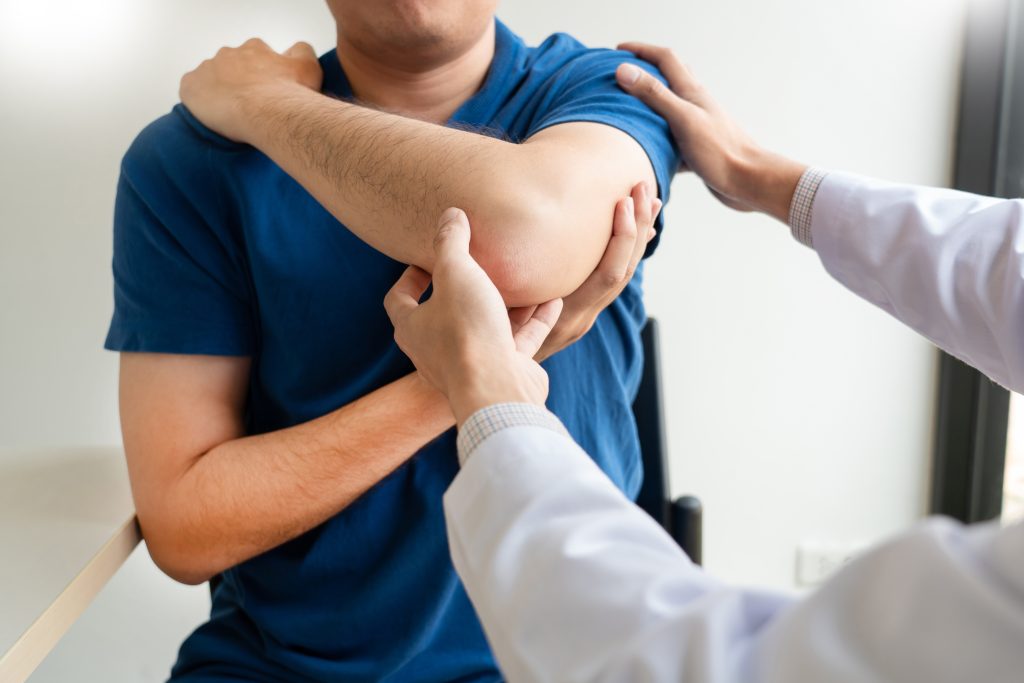Tennis elbow
Can your technique and equipment prevent you from getting it?

How to prevent tennis elbow by using the right techniques and equipment.
Posted on Mon Jul 1, 2019
Consultant Orthopaedic Surgeon, Mr Nick Ferran, explains how to minimise the risk of getting tennis elbow, and how to treat it if you do.
What is tennis elbow?
Tennis elbow is a degenerative disease affecting one of the tendons attached to the elbow’s outside (lateral side), which is responsible for extending the wrist joint. It is also known as lateral epicondylitis and is just one of the causes of pain on the outside of the elbow.
The “itis” in the name often gives the impression that this is an inflammatory condition, however, tennis elbow is actually a degenerative process of the ECRB (extensor carpi radialis brevis) tendon at the elbow. Our tendons degenerate as we age, but in some cases, that degenerative process can become haphazard, and in some people, may become painful.
While tennis elbow can affect tennis players, it is often caused by repetitive strain or overuse activities and therefore can be brought on by or may affect work and recreational activities. The condition is often self-limiting and can get better on its own.
What can cause it in tennis players?
This condition is common in tennis players with up to half of players experiencing symptoms. The condition however affects recreational tennis players more frequently than professional tennis players. There are both technique and equipment factors that contribute to the development of tennis elbow in tennis players by causing overloading of the extensor tendons at the elbow and repetitive strain.
Is there a particular style of play that increases the risk of tennis elbow?
The backhand stroke is thought to be one of the causes of tennis elbow in tennis players. Tightening the grip on the racquet to stiffen the wrist during the shot increases the force that the wrist extensor muscles transmit to the outside of the elbow. Studies have shown that professional players decrease their grip after contact with the ball and throughout the follow-through phase of the backhand shot, whereas recreational players tend to maintain a firm grip throughout the follow-through leading to increased loading at the elbow.
Equipment can also have a role to play in developing tennis elbow while playing tennis. It has been suggested that having a racquet grip that is either too large or too small can cause a player to use higher grip forces during play and these are transmitted to the elbow. Ensuring the correct grip size reduces the grip forces transmitted to the elbow.
Proper coaching can ensure that technique is sound, and the equipment is size appropriate for the player and may help avoid developing tennis elbow.
How can tennis elbow be treated?
Self-management of early symptoms includes avoidance of the activities that aggravate the pain. Painkillers including anti-inflammatory medication, and tennis elbow splints are also advisable. Avoidance of the aggravating factors can often make the condition better, however, the natural history of the disease shows that if left alone, in most studies, tennis elbow gets better after a year without any treatment in 80-90% of patients. Backing off from play or training for a bit and having technique and equipment checked by a coach can help with symptoms and allow a safe return to play.
Tennis elbow splints are affordable and accessible online. When choosing a tennis elbow splint, ensure that it is one with a cushioned pad. A recent study has shown tennis elbow splints can be very effective in managing the symptoms of tennis elbow if worn and used correctly. Tennis elbow splints work by offloading the diseased tendon attachment at the elbow.
To do this, the splint’s cushion must be worn on the forearm away from the elbow and placed correctly over the ECRB tendon. The correct positioning is often demonstrated in diagrams on the leaflet in the package.
Splints are meant to offload the tendon during repetitive aggravating activities such as work or sport if they can’t be avoided, therefore, splints should only be used during activity and not all the time. I would certainly recommend against using a tennis elbow splint at rest or while sleeping.
What is the role of physiotherapy in treatment?
Physiotherapy is the only consistently proven treatment to alter the natural history (no treatment) of tennis elbow. Physiotherapy should be focused on strengthening the wrist extensors and this may often be in a 12-week strengthening exercise programme. The whole kinetic chain should be addressed, so the hand, wrist, elbow, shoulder, core, and opposite lower limb should be activated as much as possible during physiotherapy. The role of stretching in the treatment of tennis elbow is limited and strengthening should be the primary focus.
Other newer physiotherapy approaches provide patients with a warm-up program of exercise that they can do before and during breaks in work or sport, which allow patients to carry on the repetitive aggravating movements that they may be unable to avoid.
Should steroid injections be used in tennis elbow?
Steroid injections were used routinely to help the symptoms of tennis elbow. Steroids normally work by reducing inflammation, however, they have several side effects including weakening tendons. Several recent research studies have been published that show that although steroid injections can improve the symptoms of tennis elbow within the first 6 weeks, 1 year after injection, patients’ pain returned and the patients treated with steroid injections were worse than those who weren’t treated at all.
Some of these studies have shown that steroid injections can also diminish the effects of physiotherapy so that patients treated with physiotherapy and steroid injection are worse off at 1 year than patients who received no treatment at all. For this reason, I no longer offer or recommend steroid injections to patients for treatment of this condition.
Is there a role for surgery in tennis elbow?
Patients should be referred to a specialist if symptoms do not settle with a good course of physiotherapy. The specialist would re-examine the patient’s elbow and may do investigations such as X-rays, or an MRI scan to confirm the diagnosis and rule out other causes of pain on the outside of the elbow. Surgery may be indicated if the diagnosis is confirmed and has not responded to conservative management and is causing the patient’s disability.
The outcomes of surgery can be unpredictable without following these steps. If surgery is needed I recommend an arthroscopic (keyhole) tennis elbow release which takes away the degenerate tendon tissue. I prefer to do this with keyhole surgery as it causes minimum damage to normal tissues, allows other causes of elbow pain to be addressed and allows early recovery.
What if I’m afraid of having a general anaesthetic or have had bad experiences with anaesthetics?
I often recommend to my patients that they have their shoulder and elbow surgery done with the patient awake using regional anaesthesia. The anaesthetist uses ultrasound guidance to put local anaesthetic near the nerves in the neck and arm numbing them and allowing safe surgery while the patient is awake. Awake shoulder and elbow surgery will enable patients to avoid the risks of general anaesthetics and allows quicker recovery and better post-operative pain relief.
To find out more about awake shoulder and elbow surgery and other shoulder or elbow conditions, visit our website and subscribe to our YouTube channel.
Oryon Develop
At Oryon Develop we offer a range of healthcare CPD courses to allied healthcare professionals.
Mr Nick Ferran, teams up with specialist Elbow Physiotherapist, Ms Val Jones for a webinar to tackle this challenging condition in an edge-of-your-seat doubles match to examine the aetiology, diagnosis and best treatment options available.
Watch the webinar on-demand to learn more and earn 2 hours of CPD.
Mr Nick Ferran is a Consultant Orthopaedic Surgeon, practising at Shoulder & Elbow London.
Oryon Imaging
Oryon Imaging offers affordable private MRI scans, ultrasound scans, X-rays and DEXA scans in London.
Share this article
Most Recent
Posted on Thu Jul 3, 2025
How Long Does A Shoulder MRI Take?
Posted on Thu Jul 3, 2025
Posted on Tue Jul 1, 2025
Stay up to date
If you’re interested in keeping up with what we’re doing, just leave your email address here and we’ll send you periodic newsletters and other updates.








